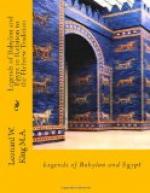(5) Gap of four, or possibly three, names.
(6) Eanna was the great temple of Erech. In the Second Column of the list “the kingdom” is recorded to have passed from Kish to Eanna, but the latter name does not occur in the summary.
(7) The name Lugalbanda
is written in the lists with and
without the determinative
for “god”.
(8) The name Dumuzi
is written in the list with the
determinative for “god”.
(9) The name Gishbilgames
is written in the list with the
determinative for “god”.
(10) Gap of about four, five, or six kings.
(11) Wanting.
At this point a great gap occurs in our principal list. The names of some of the missing “kingdoms” may be inferred from the summaries, but their relative order is uncertain. Of two of them we know the duration, a second Kingdom of Ur containing four kings and lasting for a hundred and eight years, and another kingdom, the name of which is not preserved, consisting of only one king who ruled for seven years. The dynastic succession only again becomes assured with the opening of the Dynastic chronicle published by Pere Scheil and recently acquired by the British Museum. It will be noted that with the Kingdom of Ur the separate reigns last for decades and not hundreds of years each, so that we here seem to approach genuine tradition, though the Kingdom of Awan makes a partial reversion to myth so far as its duration is concerned. The two suggested equations with Antediluvian kings of Berossus both occur in the earliest Kingdom of Kish and lie well within the Sumerian mythical period. The second of the rulers concerned, Enmenunna (Ammenon), is placed in Sumerian tradition several thousand years before the reputed succession of the gods Lugalbanda and Tammuz and of the national hero Gilgamesh to the throne of Erech. In the first lecture some remarkable points of general resemblance have already been pointed out between Hebrew and Sumerian traditions of these early ages of the world.



